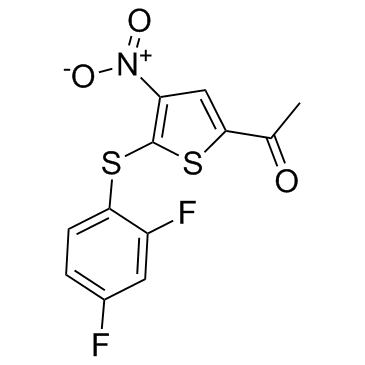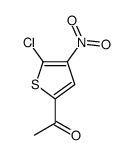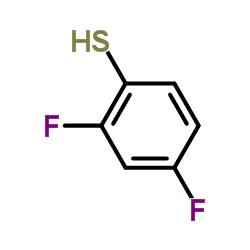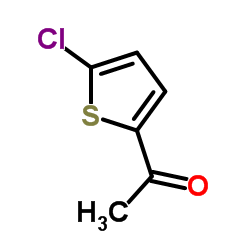1247819-59-5
| Name | 1-[5-(2,4-difluorophenyl)sulfanyl-4-nitrothiophen-2-yl]ethanone |
|---|---|
| Synonyms |
1-[5-(2,4-difluorophenylsulfanyl)-4-nitro-2-thienyl]ethanone
QC-8199 1-(5-(2,4-difluorophenylthio)-4-nitrothiophen-2-yl)ethanone P22077 P 22077 |
| Description | P 22077 is a cell-permeable ubiquitin-specific protease 7 (USP7) inhibitor with an EC50 of 8.01 μM. It also inhibits USP47 with an EC50 of 8.74 μM. |
|---|---|
| Related Catalog | |
| Target |
EC50: 8.01 μM (USP7), 8.74 μM (USP47)[1] |
| In Vitro | P 22077 is an inhibitor of USP7 and DUB USP47, with EC50s of 8.01 μM and 8.74 μM, respectively. P 22077 (15-45 μM) inhibits a much smaller subset of DUBs. P 22077 (25 μM) causes DUBs inhibition in HEK293T cells[1]. P 22077 (0-20 μM) greatly reduces the cell viability of Neuroblastoma (NB) cells including IMR-32, NGP, CHLA-255, and SH-SY5Y cells but without NB-19 and SK-N-AS cells. P 22077 (10 μM) increases p53 activity and induces apoptosis in p53 wild-type and HDM2-expressing NB cells. P 22077 (5 μM) enhances the cytotoxic effect of Dox and VP-16 on NB cells, and enhances Dox- and VP-16-induced p53-mediated apoptosis[2]. |
| In Vivo | P 22077 (15 mg/kg, i.p. 21 days) shows potent antitumor activities in an xenograft mouse model bearing IMR-32-derived tumors; P 22077 also exhibits antitumor effects after treatment at 10 mg/kg for 14 days in mice bearing SH-SY5Y-derived tumors, and at 20 mg/kg for 12 days in mice bearing NGP-derived tumors[2]. |
| Kinase Assay | Recombinant full length USP7, USP2 core, USP5, JOSD2, DEN1, PLpro core, and SENP2 catalytic core are generated. Amino terminal His6 tagged USP4, USP8, USP28, UCH-L1, UCH-L3, UCH-L5, and MMP13 are expressed in Escherichia coli. N-terminal His6 tagged USP15, USP20, and USP47 are expressed in Sf9 cells. All the recombinant proteins are purified by chromatography. Amino terminal tagged His6 Ub-PLA2 (Ub-CHOP), SUMO3-PLA2 (SUMO3-CHOP), ISG15-PLA2 (ISG15-CHOP), NEDD8-PLA2 (NEDD8-CHOP), Ub-EKL (Ub-CHOP2), and free catalytically active PLA2 are prepared[1]. |
| Cell Assay | Cell viability assays are assessed using the Cell Counting Kit-8 (CCK-8, WST-8[2-(2-methoxy-4-nitrophenyl)-3-(4-nitrophenyl)-5-(2,4-disulfophenyl)-2 H-tetrazolium, monosodium salt]). Cells are seeded in 96-well flat-bottomed plates at the density of 1 × 104 per well. After 24 h of incubation at 37°C, increasing concentrations of P 22077, Dox, VP-16, or their combinations are added to the wells. Twenty-four hours later, 10 μL of CCK-8 is added into each well and after 1 h of incubation, the absorbance is measure at 450 nm using the microplate reader. Each experiment is performed in replicates of six. Background reading of media only is used to normalize the results[2]. |
| Animal Admin | The orthotopic Neuroblastoma (NB) mouse model is used in the assay. Briefly, 1.5 × 106 human IMR-32, SH-SY5Y, or NGP cells with luciferase expression are surgically injected into the left renal capsule of 5-week-old female NCR nude mice. IMR-32, SH-SY5Y, and NGP-derived xenografts are allowed to grow for ∼2-3 weeks before randomizing the mice into a control group and a P 22077 treatment group. Each group consists of three or six mice. Animals are treated with DMSO or P 22077 by intraperitoneal (i.p.) injection every day for 12, 14, or 21 days. At the end of the experiments, all mice are killed. Tumors and the right side control kidneys are resected, weighed, and photographed[2]. |
| References |
| Molecular Formula | C12H7F2NO3S2 |
|---|---|
| Molecular Weight | 315.31600 |
| Exact Mass | 314.98400 |
| PSA | 116.43000 |
| LogP | 4.81150 |
| Storage condition | -20℃ |



